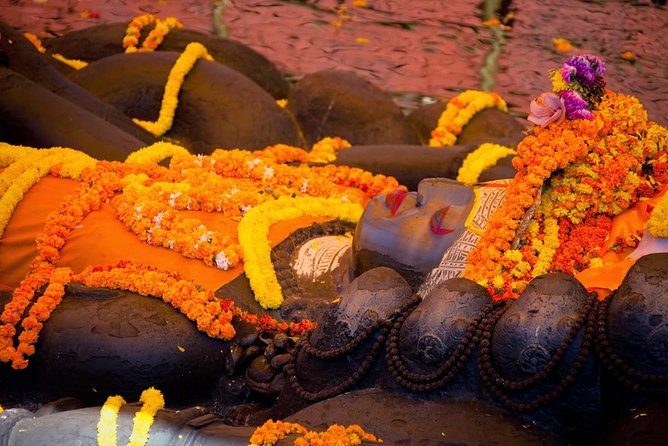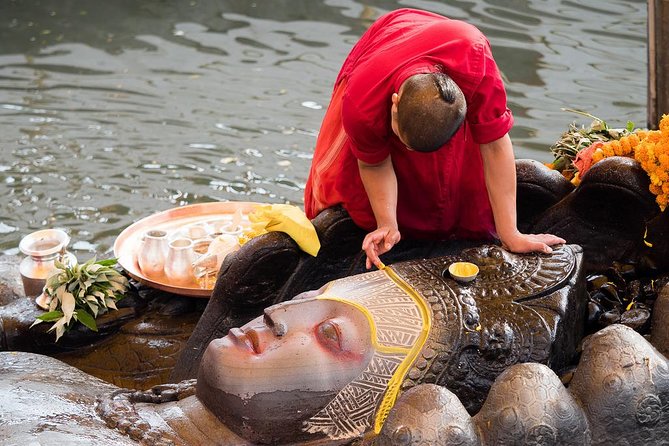Visit Budhanilkantha Temple – The House of the Sleeping Lord Vishnu
Like a hidden gem nestled amidst the bustling city of Kathmandu, Budhanilkantha Temple stands as tranquil as a whisper in a crowded room, beckoning visitors to uncover its mysteries.
The allure of the Sleeping Lord Vishnu’s abode is not just in its ancient walls but in the profound spiritual journey it offers. As travelers step foot into this sacred sanctuary, they are met with a sense of reverence that lingers long after their departure.
Curious to unravel the secrets veiled within this divine haven, one can’t help but be intrigued by the spiritual treasures awaiting at Budhanilkantha Temple.
Key Points
- Budhanilkantha Temple represents cosmic balance and harmony through Lord Vishnu.
- Devotees offer flowers, fruits, and incense in rituals symbolizing devotion.
- The temple showcases rich cultural heritage of Hindu traditions and Nepalese architecture.
- Visitors should adhere to etiquette, dress modestly, and immerse in local culture for a fulfilling experience.
Here's some more nearby activities we've reviewed
History of Budhanilkantha Temple

Nestled in the Kathmandu Valley of Nepal lies the historical Budhanilkantha Temple, a sacred site steeped in rich Hindu traditions and lore. The temple, also known as the Narayanthan Temple, holds immense cultural heritage and significance.
One of its most prominent features is the mesmerizing sculpture of Lord Vishnu reclining on the coils of the cosmic serpent Shesha. This sculpture symbolizes Lord Vishnu’s cosmic dreams and the preservation of the universe. The intricate details in the sculpture reflect the artistic prowess of the craftsmen of that era and the deep spiritual beliefs of the Hindu devotees.
Visitors to Budhanilkantha Temple aren’t only captivated by the beauty of the statue but also by the profound cultural and religious meanings it embodies.
Significance of Lord Vishnu’s Statue
Lying majestically within the sacred grounds of the Budhanilkantha Temple in Nepal, the reclining statue of Lord Vishnu on the cosmic serpent Shesha signifies profound cosmic symbolism and spiritual significance. This iconic statue holds great importance in Hindu culture and beliefs, representing various aspects that resonate deeply with worshippers and visitors alike.
The significance of Lord Vishnu’s statue can be understood through the following points:
- Symbolic Representation:
- The reclining posture symbolizes the preservation and support of the universe by Lord Vishnu.
- Lord Vishnu resting on Shesha represents the cosmic balance and harmony in creation.
- The four hands of Lord Vishnu hold symbolic objects that carry deeper spiritual meanings.
This representation at Budhanilkantha Temple showcases the rich cultural heritage and spiritual depth of Hindu traditions.
Rituals and Offerings at the Temple

Visitors partaking in the Budhanilkantha Temple tour commonly witness a variety of meaningful rituals and offerings that play a vital role in the spiritual practices at the sacred site. Daily practices at the temple include devotees offering flowers, fruits, and incense to Lord Vishnu’s statue.
Spiritual customs such as performing aarti (lighting lamps) and reciting mantras are also prevalent. The priests conduct elaborate ceremonies throughout the day, invoking blessings for the worshippers. It’s a common sight to see pilgrims participating in rituals that have been passed down through generations, each gesture symbolizing devotion and reverence.
These rituals and offerings create a serene and spiritually enriching atmosphere at the temple, allowing visitors to experience the deep-rooted traditions of Hindu worship.
Architectural Features of the Temple
With intricate carvings adorning its walls and a towering spire reaching towards the sky, Budhanilkantha Temple showcases a blend of traditional Nepalese architecture and Hindu symbolism.
The architectural features of the temple are a sight to behold, offering visitors a glimpse into the rich cultural tapestry of Nepal:
-
Sculptural details: Every corner of the temple is meticulously carved with intricate designs depicting various mythological scenes and deities.
-
Symbolic elements: The architecture is rich in symbolic elements like the lotus flower symbolizing purity and divinity, and the serpents representing cosmic energy.
-
Towering spire: The temple’s towering spire, known as a shikhara, is a prominent feature that symbolizes the connection between earth and heaven.
Tips for Visiting Budhanilkantha Temple
Amidst the stunning architectural features of Budhanilkantha Temple, visitors can enhance their experience by following these essential tips for a memorable visit.
When visiting the temple, it’s important to adhere to visiting etiquette by being respectful of the worshippers and maintaining a quiet and reverent attitude.
Plus, don’t miss the opportunity to indulge in local cuisine nearby to truly learn about the Nepalese culture. Sampling dishes like momos or dal bhat can add an extra layer of authenticity to your visit.
Remember to dress modestly and remove your shoes before entering the temple premises as a sign of respect.
Here's a few more nearby tours and experiences we have reviewed.
- Kathmandu: Mount Everest Scenic Tour by Plane With Transfers
- Kathmandu: City Flavors Guided Walking Tour
- Spiritual Nepal: Expert Insight Into Hinduism and Buddhism
- Experience Luxury Travel: Pokhara to Kathmandu by Sofa Bus
- From Kathmandu: Nagarkot Panoramic Day Hike With Lunch
- Kathmandu: Private One Day Nagarkot Sunrise and Hiking Trip
Common questions
Are There Any Specific Dress Code Requirements for Visitors to the Budhanilkantha Temple?
Visitors to the Budhanilkantha Temple should follow specific dress code requirements and cultural etiquette. Modest clothing covering shoulders and knees is customary. Removing footwear before entering the temple premises is a sign of respect.
Is Photography Allowed Inside the Temple Premises?
Photography is not allowed inside the temple premises due to cultural norms and etiquette. Visitors should respect local customs by refraining from taking pictures. It is important to follow these guidelines to show reverence.
Are There Any Particular Times of the Day When the Temple Is More Crowded With Worshippers?
Peak hours at Budhanilkantha Temple vary, with mornings generally busier due to Hindu rituals and ceremonies. Quiet times can be found in the early afternoon or later in the evening. It’s advisable to plan visits accordingly.
Can Visitors Participate in Any Rituals or Ceremonies at the Temple?
Visitors at the Budhanilkantha Temple can participate in sacred rituals for a cultural experience, connecting spiritually through ceremonial offerings. Engage in the temple’s traditions to deepen your understanding and respect for Hindu practices.
Are There Any Nearby Attractions or Places of Interest That Visitors Can Explore After Visiting the Budhanilkantha Temple?
After visiting the Budhanilkantha Temple, visitors can explore nearby attractions like Shivapuri Nagarjun National Park for nature hikes or Thamel for its vibrant local markets offering handicrafts and traditional Nepalese souvenirs.
Here's more of our most recent tour reviews happening neaby
- Kathmandu: Day Hiking Around Kathmandu Valley
- 17 Days Adventurous Annapurna Tilicho Pass Trekking
- Tamang Heritage Trail Trekking
- Private Tour of Pashupatinath and Bouddhanath
- Trishuli River Rafting
- Trishuli River Rafting Day Trip From Kathmandu
- 11 Days Spectacular Mardi Himal Homestay Trek
- Kathmandu: 6-Day Kathmandu and Lumbini Tour
- Tibet Tour 6 Days
- Everest Base Camp Trek With Helicopter Return – 9 Days
- Everest Basecamp Trekking With Luxury 5 Star Accommodation
Last Words
Set out on a transformative journey to Budhanilkantha Temple, where the ancient traditions and divine wonders of Hindu mythology come to life. Explore the rich history, significance of Lord Vishnu’s statue, and learn about the rituals and offerings of this sacred site.
Witness the architectural marvels and experience a traditional Nepalese lunch, all while gaining a deeper understanding of the cultural and spiritual essence of this enchanting temple. Don’t miss this opportunity for a truly unforgettable experience.